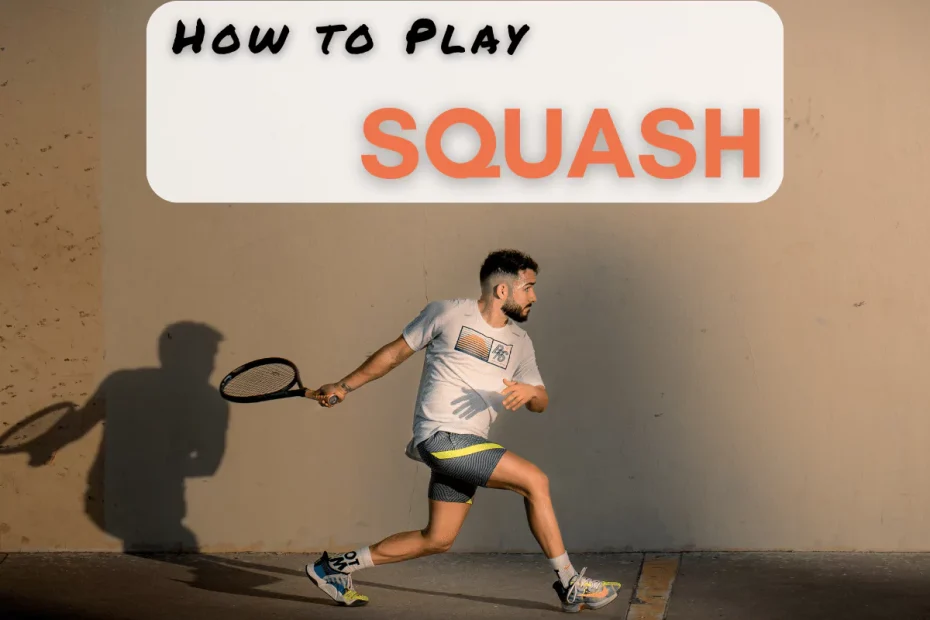Welcome to Boredom Busted’s fun and informative guide on how to play squash! If you’re looking for a new hobby to chase away boredom, squash is an exhilarating and fast-paced sport that will keep you entertained and fit.
In this squash beginners guide, we’ll cover the basics of squash, how to start playing, and some tips and tricks once you’ve learned the basics of this fun competitive sport.
So, let’s dive into this exciting world and bust that boredom! Don’t forget to check out our Definitive Hobbies List for more boredom-busting ideas.

Article Content:
So, What is Squash?
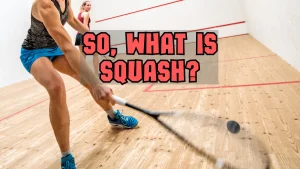
Squash is a high-energy sport that has players bouncing off the walls – literally! This fun racquet sport is an exhilarating hobby that demands agility, strategic play, and swift reflexes.
Played within a four-walled court using a small rubber ball, this fast-paced game provides a rigorous workout and a test of skill.
It’s a sport that tests your physical abilities and mental processing.
A Brief History of Squash
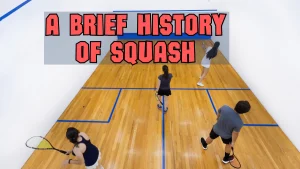
Squash traces its roots back to the 19th century. It was invented at Harrow School in England around 1830 when students discovered that a punctured ball, which “squashed” on impact with the wall, produced a game with a greater variety of shots and required more effort to retrieve the ball. Thus, the game of squash was born.
Initially, the sport was confined to schools and universities, but its popularity rapidly spread, and by the early 20th century, squash courts had sprung up around the world. Today, squash is played in more than 185 countries, with professional tournaments that attract players from every corner of the globe.
Source: Squash (sport) – Wikipedia
What Are The Benefits of Playing Squash?

Playing squash is not just a great way to have fun, it’s also an excellent workout. Here are some key benefits of getting involved in squash:
1. Squash is a Fun Hobby!
Squash is a quick, high-energy game that keeps you on your toes. The thrill of chasing the ball, executing the perfect shot, and outmaneuvering your opponent makes every match exciting.
2. Social Interaction
Squash is a social sport. Whether you’re playing a friendly match against a friend or participating in a club tournament, it provides plenty of opportunities to meet new people and build friendships.
3. Squash is Full Body Workout
Squash is a dynamic sport that exercises every part of the body – from your legs moving you around the court, to your core keeping you balanced, to your arms and shoulders swinging the racquet.
4. Squash is Good for Cardiovascular Fitness
With all the running, leaping, and diving while playing, squash gets the heart pumping, improving cardiovascular health.
5. Squash helps Flexibility & Agility
Playing squash can improve flexibility and agility as it requires quick directional changes and fast reflexes to return the ball.
6. Squash Can Improve Mental Fitness
Squash isn’t just physically challenging; it’s a mental workout too. Players need to out-think their opponent, strategizing several moves ahead, similar to chess.
7. Squash Provides Stress Relief
Like any form of exercise, squash can help reduce stress and anxiety. Plus, it’s a great way to have fun and let off steam!
8. You can Play Squash Anytime, Anywhere
Squash can be played year-round, regardless of weather, and courts are increasingly common in sports centers and clubs, making it an accessible hobby for many.
Whether you’re looking to pick up a new hobby, get in shape, or challenge yourself mentally and physically, squash might just be the sport for you.
Related: Top Benefits of Hobbies
How to Play Squash: Understanding the Basic Rules
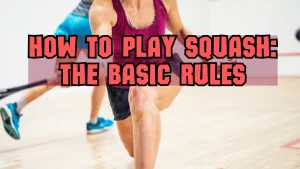
Playing squash is a lot of fun, and it can be quite the workout! But before you can start swinging that racquet, it’s important to understand the basic rules of the game of squash.
Here are the essential rules you need to know when learning how to play squash:
-
Starting the Game with a Serve
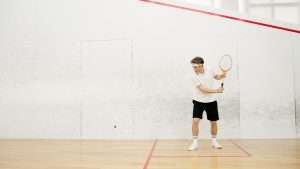
The game of squash begins with a serve. The server can choose which service box to serve from for the first point.
The serve must be hit above the middle line (service line) and below the outline on the front wall and must land in the opposite back quarter of the court. After the first point, the server serves from the alternate service box each time they win a point.
-
Hitting the Ball Against the Front Wall

The first rule of squash is that players must alternate in hitting the ball against the front wall. The ball must land above the tin (the metal strip at the bottom of the front wall) and below the outline (the boundary at the top).
-
The Ball Can Hit the Side or Back Walls
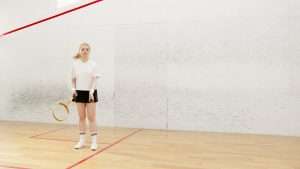
After hitting the front wall, the ball is allowed to hit the side or back walls. However, it’s important to note that it must not touch the floor before reaching the front wall.
-
The Ball Can Only Bounce Once

In squash, the ball is only allowed to bounce once on the floor. After that, the opponent must return it. If you fail to hit the ball before it bounces twice, your opponent wins the point.
-
Fair Play & Obstruction

Squash is a sport that values fairness. Players must allow their opponent a fair chance to hit the ball. If a player is obstructed from reaching the ball, a ‘let’ or ‘stroke’ may be awarded, depending on the situation.
A ‘let’ means the point is replayed, while a ‘stroke’ awards the point to the obstructed player.
-
Completing a Match
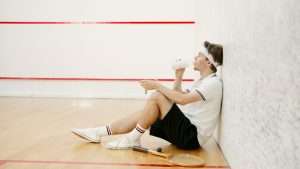
A squash match is typically played as the best of 5 games. Each game goes to 11 points, but must be won by two clear points.
For example, if the score reaches 10-10, play continues until one player leads by two points. The player who wins three games first wins the match. Once the match is completed, it’s customary to shake hands with your opponent and, if applicable, the referee.
Estimated Cost: 100 USD
Tools:
- Squash Racquet
- Squash Rubber Ball
- Squash Goggles / Eyewear
- Squash Shoes
Equipment needed:

To start playing squash, you’ll need the following equiIn addition to a squash racquet and balls, consider investing in comfortable sportswear and proper squash shoes for safe and effective play.
The total cost, including gear and court access, would likely range from $100 to $400 for your initial investment. But remember, once you’ve got your equipment, the ongoing cost is generally just the court fee, making squash a fairly affordable hobby in the long run!
- Squash racquets: Choose a racquet that feels comfortable and suits your playing style. Racquets vary in weight, balance, and head size. Beginners might prefer a lighter racquet for easier maneuverability.
- Squash balls: Squash balls come in different colors and speeds, denoted by colored dots. Beginners should start with a blue or red dot ball, which bounce more and are easier to hit.
- Squash shoes: Proper squash shoes provide good grip on the court and have non-marking soles to avoid damaging the court surface.
- Squash goggles: Protective eyewear is essential for preventing eye injuries during play.
Squash Serve Rules: Mastering the Art of the Serve
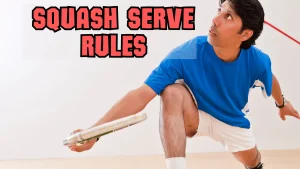
The serve is a crucial part of every squash game, setting the tone for the rally.
Understanding and mastering the squash serve rules can give you a competitive edge and a primary skill to hone when learning how to play squash.
Here’s everything you need to know about serving in squash:
Squash Serve Basics
In squash, the server gets to choose the service box (left or right) to start the game.
The player must keep one foot inside this box until they strike the ball.
The serve ball must hit the front wall above the service line and below the outline. From the front wall, the ball must land in the opposite back quarter of the court.
If the server wins the rally, they switch to the alternate service box for the next serve.
Faults in Squash Serving
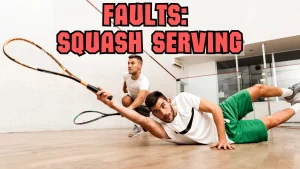
Serving in squash comes with its own set of rules and violating any can result in a fault, giving the point to the opponent. Here are common scenarios that result in faults:
- Foot Fault: If the server steps out of the service box before striking the ball, it’s considered a foot fault.
- Line Fault: If the served ball hits the front wall below the service line or above the outline, it’s a line fault.
- Quarter Court Fault: The served ball must land in the opposite back quarter on the first bounce. If it doesn’t, it’s a quarter court fault.
Understanding these rules can help improve your serve, a vital part of becoming a proficient squash player.
When learning how to play squash, you’ll want to practice your serve regularly, aiming for consistency and accuracy, and you’ll soon see improvements in your squash game!
Squash court Information
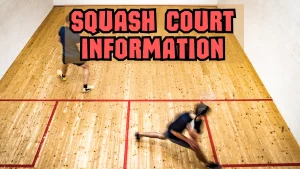
Quickly, let’s go over the size of a squash court. A squash court consists of four walls: front, back, and two side walls. The dimensions are:
- Length: 32 feet (9.75 meters)
- Width: 21 feet (6.4 meters)
- Height to the outline: 15 feet (4.57 meters)
The Squash court has several key features:
- Tin: A horizontal metal strip at the bottom of the front wall, 19 inches (48 cm) high.
- Service boxes: Two squares on opposite sides of the court where the server must stand.
- Service line: A horizontal line on the front wall, 6 feet (1.83 meters) above the floor.
Where to Find a Squash Court Near you?
Finding a squash court to play on is an essential first step to get started with the game.
Here are a few places where you can find a squash court:
- Local Sports Centers and Gyms: Many local sports centers and gyms have squash courts available for use. Some may require membership, while others may allow you to book a court for a specific time slot for a fee.
- Squash Clubs: Squash clubs are dedicated facilities that offer a range of services including court hire, coaching, and tournaments. Joining a squash club can also be a great way to meet other players and get involved in the squash community.
- Universities and Schools: Some universities and schools have squash courts that are available for public use outside of school hours. This can be a cost-effective way to access a court.
- Online Directories: Websites like SquashFinder and SquashCourts.com provide a directory of squash courts across various countries, making it easier to find a court near you.
Typical Squash Court Cost:
The cost of hiring a squash court can vary greatly depending on the location, facility, and time of booking.
Here are some general estimates:
- Sports Centers and Gyms: Court hire at a local sports center or gym typically ranges from $10 to $30 per hour. Some facilities may offer discounted rates during off-peak hours or for members.
- Squash Clubs: Squash clubs may require a membership fee, which can range from $50 to $200 per year, depending on the club. Court hire is often cheaper for members, and some clubs may even include free court time in their membership packages.
- Universities and Schools: Court hire at universities and schools can be a cost-effective option, with prices generally ranging from $5 to $20 per hour.
- Private Clubs: Private clubs or luxury sports centers may charge $50 or more per hour for court hire, but these facilities often include additional amenities such as locker rooms, equipment hire, and cafés.
Remember, the costs mentioned are estimates and can vary based on location, facility, and time. It’s always a good idea to check with the facility for the most accurate and up-to-date prices.
Tips & Techniques for Squash Beginners
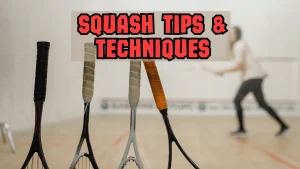
Now that we’ve covered the basics of squash, what you need to play, and where to find a court – let’s chat about different tips and techniques you can start using when learning how to play squash!
You Should Warm up before playing
Warming up is essential before playing squash to prevent injuries and prepare your body for the intense activity.
Start with some light cardio exercises, such as jogging or skipping rope, for 5-10 minutes. Then, perform stretches targeting your shoulders, wrists, hips, and ankles to ensure flexibility and range of motion.
Learn some Basic squash shots
When you’re learning how to play squash, you should familiarize yourself with these basic and easy shots:
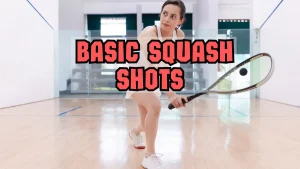
- Drive: A straight shot hit along the side wall, aimed to land deep in the backcourt. This shot is used to keep your opponent at the back of the court and establish control of the rally.
- Boast: A shot that hits the side wall before reaching the front wall, creating a unique angle that can catch your opponent off-guard. Boasts can be played from the front or the back of the court, depending on the situation.
- Volley: Hitting the ball before it bounces on the floor, enabling you to take control of the rally and put pressure on your opponent.
Practice some Basic Squash tactics & Strategies
When you’ve finished learning how to play squash, you should look to improve your game.
You should consider these basic squash tactics:
- Keep your opponent moving around the court by varying your shots and targeting their weak areas.
- Focus on hitting the ball tight to the side walls, making it harder for your opponent to return.
- Maintain a central position (the “T” area) in the court to allow for better coverage and faster reactions to your opponent’s shots.

Improving your squash skills
To further develop your squash skills, try these doing these tips:
- Practice regularly and consider taking lessons or joining a club to learn from experienced players.
- Watch professional squash matches to observe the techniques and strategies used by top players.
- Focus on improving your fitness and agility through cross-training, such as running, swimming, or yoga.
Playing Squash Alone: A Solo Practice Guide
While squash is typically a two-player sport, you can absolutely practice playing squash alone.
Learning how to play squash alone is a fantastic way to hone your skills, improve your shots, and develop a better understanding of the game. Here’s how to make the most of your solo squash sessions:
Warm-Up
Start your session with a good warm-up to get your muscles ready and your heart rate up. Jog around the court, do some dynamic stretches, and then start hitting the ball gently to warm up your swing.
Practice Your Shots
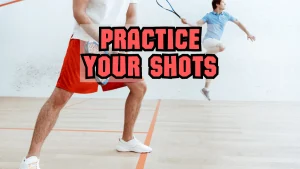
Solo practice is the perfect time to work on your shots.
Try hitting the ball to specific areas of the front wall or practice your serves. Focus on your accuracy and consistency, trying to hit the same spot multiple times in a row.
Work on Your Footwork
Good footwork is crucial in squash. Use your solo time to practice moving around the court, working on your speed, agility, and balance.
Practice lunges, sidesteps, and sprints to mimic the movements you’d make during a match.
Use Training Tools
Consider using training tools like a squash ghosting app, which can help guide your movements around the court and improve your fitness and footwork.
Cool Down
End your session with a cool-down to help your muscles recover. Stretch, walk around the court, and hydrate.
Solo squash practice can be an effective way to improve your game and get a great workout. Remember, the key to improvement is consistency.
Happy playing!
Squash FAQ’s:

Is it easy to play squash?
Yes, but with a caveat. Squash can be a challenging sport for beginners due to its fast pace and the need for agility, coordination, and fitness.
However, with practice and proper guidance, it becomes easier and more enjoyable.
Is racquetball & squash the same thing?
Although both are racket sports played in enclosed courts, they have different rules, equipment, and court dimensions.
Although both are racket sports played in enclosed courts, they have different rules, equipment, and court dimensions.
Racquetball uses a larger, more bouncy ball and has no tin or outline on the front wall.
What is more popular, squash or racquetball?
The popularity of each sport can vary depending on the region. Globally, squash is generally more popular, with a larger professional circuit and more widespread participation.
However, racquetball may be more popular in specific areas, such as the United States.
Can you serve overarm in squash?
Yes, you can. These are considered power serves and good against novice players. Serving overarm vs more experienced players is not advised as it doesn’t allow ample time to get back on defense after the serve.
Squash Conclusion

Learning how to play squash is a fun, challenging reward. Squash is an awesome, competitive sport that offers numerous physical and mental benefits. This squash for beginner’s guide has provided you with the basics of how to play squash, essential tips and techniques for beginners, and answers to frequently asked questions.
As you continue to practice and develop your squash skills, you’ll discover the excitement and enjoyment that this fun hobby has to offer.
Don’t forget to explore our Definitive Hobbies List for more engaging activities to pursue in your free time.
Glossary of Squash Terms:
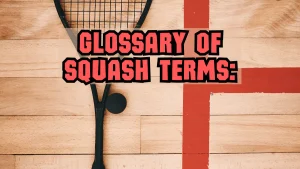
While you’re learning how to play squash, here are some terms you may run across while reading this beginners guide or other materials around the internet.
- Boast: A shot that hits the side wall before reaching the front wall, creating a unique angle that can catch your opponent off-guard.
- Court hinder: An obstruction or irregularity in the court surface that affects the ball’s trajectory, such as a wet spot or a loose floorboard. In such cases, a let is often called, and the point is replayed.
- Cross-court shot: A shot which travels diagonally across the court, hitting the front wall and then the opposite side wall, forcing the opponent to move across the court to return it.
- Drive: A straight shot hit along the side wall, aimed to land deep in the backcourt.
- Drop shot: A soft shot played close to the front wall, aiming to land just above the tin and making it difficult for the opponent to reach.
- Kill shot: A hard, low shot aimed at the front wall, typically hit with a downward angle, intending to make the ball bounce twice quickly and be difficult to return.
- Let: A situation where play is stopped, and the point is replayed due to interference or lack of access to the ball.
- Lob: A high, slow shot aimed at the back of the court, intended to give the player time to regain their position and put their opponent under pressure.
- Nick: The point where the side wall meets the floor, creating a tight angle. A shot that hits the nick can be challenging to return.
- Out of court: When a shot hits an area outside the designated court boundaries, such as the floor before the front wall, or above the outline.
- Rally: A sequence of shots between players, starting with the serve and ending when one player fails to return the ball or commits a rule violation.
- Serve: The shot that begins each rally, where the server must hit the ball from a service box, aiming for it to land in the opposite back quarter of the court.
- Stroke: A point awarded to a player when their opponent obstructs their access to the ball, preventing a legitimate shot.
- T area: The intersection of lines in the center of the court, where players aim to position themselves for optimal coverage and reaction time.
- Tin: The horizontal metal strip at the bottom of the front wall, 19 inches (48 cm) high.
- Volley: Hitting the ball before it bounces on the floor, enabling you to take control of the rally and put pressure on your opponent.
External Resources:
- Squash: Rules and how to play (olympics.com)
- Rules of Squash – World Squash
- Squash-Rules PDF(utdallas.edu)

Hey Everyone!
Chritt here. I just want to say THANK YOU SO MUCH for visiting Boredom Busted. It’s been my passion project going on 7 years now.
I need a favor though. If you have found the page you landed on or explored useful in any ways – please please please share, or comment.
The more engagement on this page – the more I can continue to write and provide helpful content to my visitors like you.
I love you all and thank you again for visiting! Don’t be a stranger and hope to see you back, soon!

